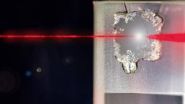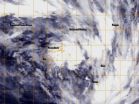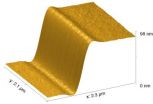(Press-News.org) Scientists at the U.S. Department of Energy's Ames Laboratory are revealing the mysteries of new materials using ultra-fast laser spectroscopy, similar to high-speed photography where many quick images reveal subtle movements and changes inside the materials. Seeing these dynamics is one emerging strategy to better understanding how new materials work, so that we can use them to enable new energy technologies.
Physicist Jigang Wang and his colleagues recently used ultra-fast laser spectroscopy to examine and explain the mysterious electronic properties of iron-based superconductors. Results appeared in Nature Communications this month.
Superconductors are materials that, when cooled below a certain temperature, display zero electrical resistance, a property that could someday make possible lossless electrical distribution. Superconductors start in a "normal" often magnetic state and then transition to a superconducting state when they are cooled to a certain temperature.
What is still a mystery is what goes on in materials as they transform from normal to superconducting. And this "messy middle" area of superconducting materials' behavior holds richer information about the why and how of superconductivity than do the stable areas.
"The stable states of materials aren't quite as interesting as the crossover region when comes to understanding materials' mechanisms because everything is settled and there's not a lot of action. But, in this crossover region to superconductivity, we can study the dynamics, see what goes where and when, and this information will tell us a lot about the interplay between superconductivity and magnetism," said Wang, who is also an associate professor of physics and astronomy at Iowa State University.
But the challenges is that in the crossover region, all the different sets of materials properties that scientists examine, like its magnetic order and electronic order, are all coupled. In other words, when there's a change to one set of properties, it changes all the others. So, it's really difficult to trace what individual changes and properties are dominant.
The complexity of this coupled state has been studied by groundbreaking work by research groups at Ames Laboratory over the past five years. Paul Canfield, an Ames Laboratory scientist and expert in designing and developing iron-based superconductor materials, created and characterized a very high quality single crystal used in this investigation. These high-quality single crystals had been exceptionally well characterized by other techniques and were essentially "waiting for their close up" under Wang's ultra-fast spot-light.
Wang and the team used ultra-fast laser spectroscopy to "see" the tiny actions in materials. In ultra-fast laser spectroscopy, scientists apply a pulsed laser to a materials sample to excite particles within the sample. Some of the laser light is absorbed by the material, but the light that passes through the material can be used to take super-fast "snapshots" of what is going on in the material following the laser pulse and then replayed afterward like a stop-action movie.
The technique is especially well suited to understanding the crossover region of iron-arsenide based superconductors materials because the laser excitation alters the material so that different properties of the material are distinguishable from each other in time, even the most subtle evolutions in the materials' properties.
"Ultra-fast laser spectroscopy is a new experimental tool to study dynamic, emergent behavior in complex materials such as these iron-based superconductors," said Wang. Specifically, we answered the pressing question of whether an electronically-driven nematic order exists as an independent phase in iron-based superconductors, as these materials go from a magnetic normal state to superconducting state. The answer is yes. This is important to our overall understanding of how superconductors emerge in this type of materials."
INFORMATION:
Aaron Patz and Tianqi Li collaborated on the laser spectroscopy work. Sheng Ran, Sergey L. Bud'ko and Paul Canfield collaborated on sample development at Ames Laboratory and Iowa State University. Rafael M. Fernandes at the University of Minnesota, Joerg Schmalian, formerly of Ames Laboratory and now at Karlsruhe Institute of Technology and Ilias E. Perakis at University of Crete, Greece collaborated on the simulation work.
Wang, Patz, Li, Ran, Bud'ko and Canfield's work at Ames Laboratory was supported by the U.S. Department of Energy's Office of Science, (sample preparation and characterization). Wang's work on pnictide superconductors is supported by Ames Laboratory's Laboratory Directed Research and Development (LDRD) funding (femtosecond laser spectroscopy).
DOE's Office of Science is the single largest supporter of basic research in the physical sciences in the United States, and is working to address some of the most pressing challenges of our time. For more information, please visit the Office of Science website at science.energy.gov/.
Ames Laboratory is a U.S. Department of Energy Office of Science national laboratory operated by Iowa State University. Ames Laboratory creates innovative materials, technologies and energy solutions. We use our expertise, unique capabilities and interdisciplinary collaborations to solve global problems.
Ultra-fast laser spectroscopy lights way to understanding new materials
2014-02-28
ELSE PRESS RELEASES FROM THIS DATE:
Detection of water vapor in the atmosphere of a hot jupiter
2014-02-28
Although liquid water covers a majority of Earth's surface, scientists are still searching for planets outside of our solar system that contain water. Researchers at Caltech and several other institutions have used a new technique to analyze the gaseous atmospheres of such extrasolar planets and have made the first detection of water in the atmosphere of the Jupiter-mass planet orbiting the nearby star tau Boötis. With further development and more sensitive instruments, this technique could help researchers learn about how many planets with water—like Earth—exist within ...
Smoke in the water: Understanding the effects of smoke compounds on seed germination
2014-02-28
Although seemingly destructive, wildfires help to maintain biodiversity and are an important element of many ecosystems throughout the world. Not only do fires discourage non-native and invasive species from becoming established, but the quick release of nutrients, heat, and compounds found in ash and smoke play an important role in the life cycle of the native flora. For plants that are adapted to ecosystems where fire is a regular occurrence—such as savannas, grasslands, and coniferous forests—exposure to fire may initiate seed germination or enhance plant growth.
Recent ...
The nature of color: New formula to calculate hue improves accuracy of color analysis
2014-02-28
A stroll through the produce aisle in your local grocery store exhibits a plethora of vivid colors. From opposing hues, like red apples next to green celery, to subtler variations, such as light to dark purple grapes, every color seems to hold its own unique attraction. Is there a way to precisely measure these hundreds of colors? This is a crucial question for scientists studying the biological importance of color in nature, but measuring color is much more challenging than measuring other characteristics, like size or weight. In recent work, University of Colorado researcher ...
Tropical Cyclone 16P forms near Fiji
2014-02-28
Tropical Cyclone 16P formed near Fiji after lingering in the region for several days as a tropical low pressure area. NOAA's GOES-West satellite captured an infrared image of the storm on February 28.
NOAA's GOES-West satellite image showed the center of Tropical Cyclone 16P to the northeast of Fiji and over Vanua Levu. Broken bands of thunderstorms wrapping from the north to the east and southeast reached Wallis and Fortuna, Samoa, Niue and Tonga.
At 0900 UTC/4 a.m. EST, Tropical Cyclone 16P was centered about 170 nautical miles/`95.6 miles/314.8 km northeast of Suva, ...
To teach scientific reproducibility, start young
2014-02-28
DURHAM, N.C. -- The ability to duplicate an experiment and its results is a central tenet of the scientific method, but recent research has shown an alarming number of peer-reviewed papers are irreproducible.
A team of math and statistics professors has proposed a way to address one root of that problem by teaching reproducibility to aspiring scientists, using software that makes the concept feel logical rather than cumbersome.
Researchers from Smith College, Duke University and Amherst College looked at how introductory statistics students responded to a curriculum ...
Asthma drug aids simultaneous desensitization to several food allergies, study finds
2014-02-28
STANFORD, Calif. — An asthma drug accelerates the process of desensitizing patients with food allergies to several foods at the same time, a new study by researchers at the Stanford University School of Medicine and Lucile Packard Children's Hospital Stanford shows.
The findings come on the heels of a recent study by the same team showing that people with multiple food allergies can be desensitized to several foods at once. The two studies, both phase-1 safety trials, provide the first scientific evidence that a promising new method for treating people for multiple food ...
Beneficial anti-inflammatory effects observed when plant extracts fed to sick pigs
2014-02-28
URBANA, Ill. – Porcine reproductive and respiratory syndrome (PRRS) is the most expensive and invasive disease for pig producers on a global scale. Though it is not occurring on every farm, it is the biggest disease problem in the pig industry, said a University of Illinois animal sciences researcher.
E. coli has also been a problem historically and continues to be on an industry-wide basis, said James Pettigrew. "Either disease can sweep through a farm so their alleviation would substantially reduce production costs. Even though many management practices have been used ...
Waterloo physicists solve 20-year-old debate surrounding glassy surfaces
2014-02-28
University of Waterloo physicists have succeeded in measuring how the surfaces of glassy materials flow like a liquid, even when they should be solid.
A series of simple and elegant experiments were the solution to a problem that has been plaguing condensed matter physicists for the past 20 years.
Understanding the mobility of glassy surfaces has implications for the design and manufacture of thin-film coatings and also sets practical limits on how small we can make nanoscale devices and circuitry.
The work is the culmination of a project carried out by a research ...
Burmese pythons pose little risk to people in Everglades
2014-02-28
EVERGLADES NATIONAL PARK, Fla. -- The estimated tens of thousands of Burmese pythons now populating the Everglades present a low risk to people in the park, according to a new assessment by U.S. Geological Survey and National Park Service scientists.
The human risk assessment looked at five incidents that involved humans and Burmese pythons over a 10-year period in Everglades National Park. All five incidents involved pythons striking at biologists who were conducting research in flooded wetlands.
"Visitor and staff safety is always our highest priority at Everglades ...
Kessler Foundation researchers find education attenuates impact of TBI on cognition
2014-02-28
West Orange, NJ. February 28, 2014. Kessler Foundation researchers have found that higher educational attainment (a proxy of intellectual enrichment) attenuates the negative impact of traumatic brain injury (TBI) on cognitive status. The brief report, Sumowski J, Chiaravalloti N, Krch D, Paxton J, DeLuca J. Education attenuates the negative impact of traumatic brain injury (TBI) on cognitive status, was published in the December issue of Archives of Physical Medicine & Rehabilitation Vol. 94, Issue 12:2562-64.
Cognitive outcomes vary post-TBI, even among individuals ...



